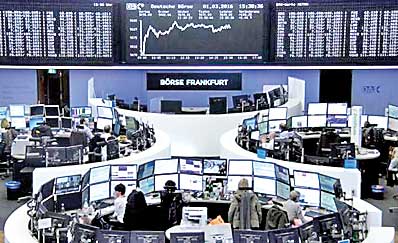Thursday Feb 13, 2025
Thursday Feb 13, 2025
Friday, 4 March 2016 00:00 - - {{hitsCtrl.values.hits}}
Reuters: European stocks and oil prices fell on Thursday but still held on to most of this week’s gains, as concern eased about the global outlook for economic growth.
Upbeat data from major economies this week and signs of a rebound in commodity prices have helped restore some calm to global markets after a turbulent start to the year.
Growth in Germany’s private sector slid to a five-month low in February but remained solid, underpinned by growing services, a survey showed on Thursday.
European stock markets .FTEU3 fell at the open but remained close to two-month highs, reflecting a more upbeat mood among investors.
Oil prices reversed earlier gains as swelling U.S. crude inventories outweighed a growing belief that the market’s 20-month-long rout is ending.
Brent crude prices LCOc1 slipped 0.9% to $36.63 but are still some 35% above last month’s lows. U.S. crude futures lost 0.4% to $34.51 CLc1. However, they have risen more than a third since Feb. 11, when prices dropped to levels not seen since 2003 at just over $26 a barrel.
The pan-European FTSEurofirst 300 was down 0.46%, with blue-chip stocks in London .FTSE, Paris .FCHI and Frankfurt .GDAXI all losing ground.
That followed a strong session in Asia, where MSCI’s broadest index of Asia-Pacific shares outside Japan .MIAPJ0000PUS added another 1.1% to reach a two-month peak.
Focus turned to the U.S. non-manufacturing ISM report, due later on Thursday, with investors eyeing the employment component for clues about Friday’s non-farm payrolls report.
A solid report on Friday could bolster expectations that the Federal Reserve remains on track to raise interest rates this year and boost the dollar.
The dollar was back above 114.00 yen JPY=, up 0.5% at 114.05 and moving towards the previous day’s two-week high of 114.56. Even the low-yielding euro was up 0.6% at 123.95 yen EURJPY=.
“We are seeing better risk appetite weighing on the yen,” said Niels Christensen, FX strategist at Nordea. “The focus is on the ISM report, and if, like the manufacturing survey, it is a good one, then we could see the dollar move higher.”
Data on Wednesday showed U.S. private-sector jobs rising a surprisingly strong 214,000 in February, adding to speculation Friday’s payrolls report would also be upbeat.
The calmer mood in world markets showed in the CBOE Volatility index .VIX, a measure of investor anxiety, which closed at its lowest level so far this year.
Against this backdrop, U.S. Treasury and German Bund yields have pulled away from lows hit in February as greater risk appetite lessens the appeal of safe-haven bonds.
The Australian dollar was up 0.2% to $0.7303 AUD=D4 after earlier reaching a 2016 high of $0.7325. Data showed Australia’s fourth-quarter economic growth unexpectedly picked up to an annual 3.0%.
Yet fissures remain in the global outlook, with the European Central Bank likely to ease monetary policy further when it meets next week.
“The overriding economic concerns that were vexing investors at the end of last year are still here - concerns about a weaker Chinese economy, for instance,” said Michael Hewson, chief markets analyst at CMC Markets in London. “That makes me cautious about the rebound in stock markets.”
Discover Kapruka, the leading online shopping platform in Sri Lanka, where you can conveniently send Gifts and Flowers to your loved ones for any event including Valentine ’s Day. Explore a wide range of popular Shopping Categories on Kapruka, including Toys, Groceries, Electronics, Birthday Cakes, Fruits, Chocolates, Flower Bouquets, Clothing, Watches, Lingerie, Gift Sets and Jewellery. Also if you’re interested in selling with Kapruka, Partner Central by Kapruka is the best solution to start with. Moreover, through Kapruka Global Shop, you can also enjoy the convenience of purchasing products from renowned platforms like Amazon and eBay and have them delivered to Sri Lanka.
Discover Kapruka, the leading online shopping platform in Sri Lanka, where you can conveniently send Gifts and Flowers to your loved ones for any event including Valentine ’s Day. Explore a wide range of popular Shopping Categories on Kapruka, including Toys, Groceries, Electronics, Birthday Cakes, Fruits, Chocolates, Flower Bouquets, Clothing, Watches, Lingerie, Gift Sets and Jewellery. Also if you’re interested in selling with Kapruka, Partner Central by Kapruka is the best solution to start with. Moreover, through Kapruka Global Shop, you can also enjoy the convenience of purchasing products from renowned platforms like Amazon and eBay and have them delivered to Sri Lanka.